Hunting Small Stream Trout in Australia… by Arno Crous
I suppose the question is what constitutes a small stream? In the fly-fishing world, this is akin to asking a random person where the colour blue starts and ends in the visible light spectrum. Yes, one can get extremely serious with explanations, about precise stream widths, depths, flow-rates, etc. etc. but nine times out of ten the answer is going to vary from person to person.
Click on images to enlarge
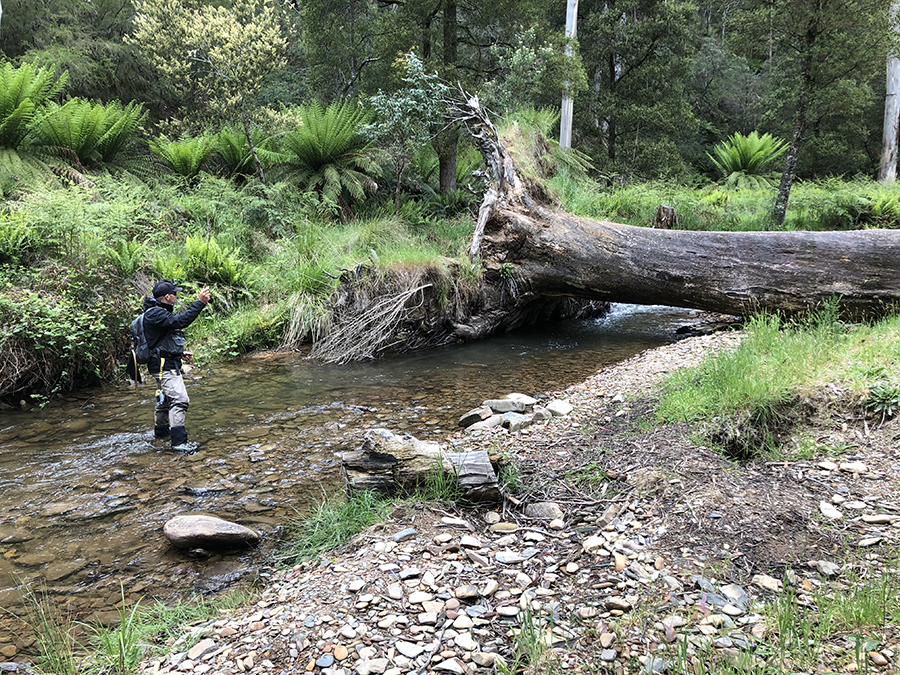
The author's friend Daryl Human on his favourite creek, the Upper Goulburn
For me the question is far more loosely defined and constantly, possibly conveniently, I will mould the answer to suite as I go along. My idea of a small stream might mean a trickle hardly worth looking at to some anglers but a bit on the large side for others, and I am happy with that. Small streams are not much of a large-crowd spectator sport anyway, so you are not likely to disappoint many people if your version of a small stream doesn’t line up with everyone else’s.

A trickle hardly worth looking to some – Riley Creek
Small streams are not known for being easy and in that probably lies part of their allure. It hints at your needing to bring you’re A-game, despite contrarily at times giving you a false sense of being easy. The residents live a hard life and due to the nature of things, need to be on the ball to survive and require the fly angler to be equally on the ball. The fact that they are normally exceptionally pretty and secluded is a bonus, but a bonus that may just be the main reason you fish for them in the first place.
Luckily Australia’s South-East corner is blessed with a considerable number and variety of small streams that feed the bigger, better-known trout rivers. When I moved to Melbourne from South Africa in 2008, I initially only had eyes and ears for the big-name rivers and places in this part of the world, such as in New Zealand and Tasmania, but I have been pleasantly surprised by the quantity and quality of the trout fishing available on mainland Australia. The larger better-known trout streams and rivers tend to act as a filter that weeds out the number (and the less dedicated) anglers that end up fishing the small streams.
If you are interested in a reasonable set out of these better known, larger streams and rivers (with a couple of smaller streams mentioned), you can’t go wrong getting a copy of one of several books by Philip Weigall on fly fishing waters of Victoria and Southern NSW.
My involvement in the 4x4 industry gave me the opportunity to explore large parts of the Victorian High Country and the Snowy Mountains area of southeastern New South Wales. This part of the country consists mostly of rugged mountainous terrain, far removed from the flat desert outback country that Australia is mostly known for. Millennia of precipitation have carved countless steep-sided, wrinkled valleys out of the mountains. This same precipitation also fuels the thirsty Eucalyptus trees that cover these steep slopes as far as the eye can see.
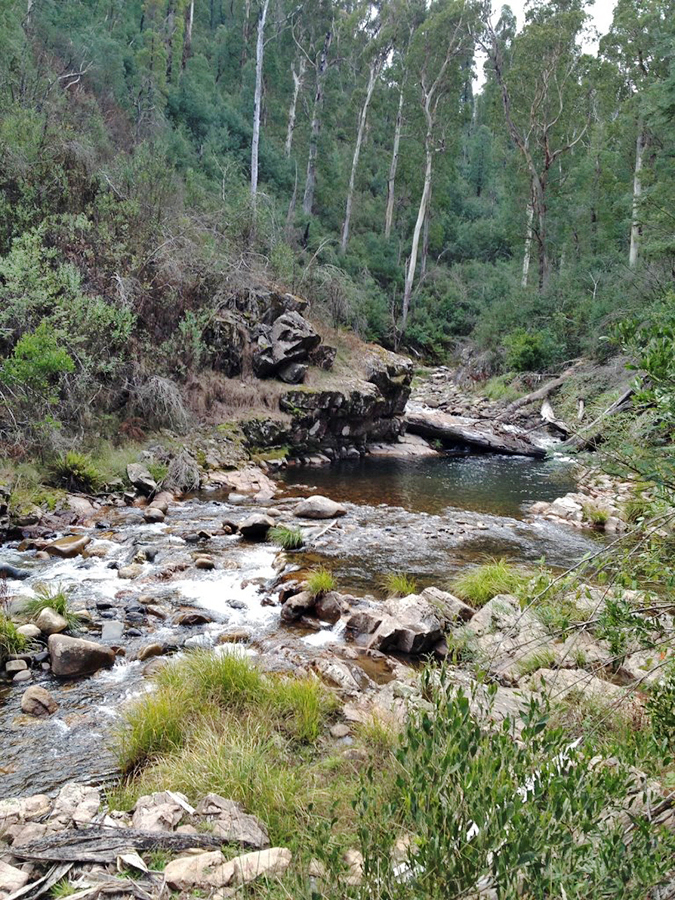
Thirsty Eucalyptus trees cover these steep slopes – The Howqua River
They fight each other for sunlight, growing to incredible heights, producing arguably the tallest flora in the world. Some that have escaped the old timer’s axes are known to grow well and truly past 100m in height. The tight, rugged 4x4 tracks hug the contours like frantic scribbles on Righter scale paper tracing a major earthquake. The steepness of some ascents and descents is white-knuckle stuff for the driver and passengers, with river crossings deep enough to come over the bonnet up to the windscreen wipers. Depending on the season, rain, clay, mud, snow and ice combine to test the vehicle’s traction and can slow progress to a crawl.
Skilled driving hands (plus nerves of steel) and well-prepared vehicles are in many cases the only access, but possibly herein lies the attraction. Camping is normally free (depending on if it is in a state or national park) and available almost anywhere you find a flat area, but some know camping grounds have been provided with basic long-drop toilets and possibly fireplaces and if you’re lucky picnic tables and benches. Please remove any rubbish yourself. At this point, there are a few safety items to take into account in more remote areas.
Ensure a drinkable supply of water that doesn’t weigh as much as… well, water. I started carrying a LifeStraw to drink filtered water safely straight from the river. It was a bit of a bother to go down on all fours for a drink, which is OK for an emergency, but my joints threatened to revolt. I still have this LifeStraw in the rear pocket of my fly-vest (it is light and compact enough) for emergencies, but I have started using the LifeStraw bottle as my main hydration system. I carry it empty most of the time (unless I know I am going to be walking a fair distance away from a water source, in which case I fill it up), so that it weighs next to nothing, then when I am thirsty I fill it up with water from the stream, drink my fill and empty it out until I am thirsty again… works a treat!
With the number of very venomous snakes in Australia, a snake-bite kit is most important and one of them lives permanently in my fly-vest rear pocket! I see a snake every other fishing trip, even had some in the water with me! Normally if you leave them alone, they will leave you alone. Due to the remoteness, help can be a long way away and there are two devices that I can highly recommend to carry at all times to summons the rescue troops if you need them. If you can afford it carry both. The first is a PLB (Personal Locating Beacon… very similar to an EPIRB carried on boats out at sea) and it’s better to have a PLB that gives your GPS coordinates as part of the signal when activated. One press of the SOS button and the local emergency services are called via satellite. It’s generally got a 10-year battery life and doesn’t have a monthly subscription, just needs to be registered with the relevant authorities.
The second type is called a satellite tracker. This requires a monthly subscription and also has a dedicated SOS button, but this signal, via satellite, first goes to America and from there it is relayed to the local rescue authority. So it does take a minute or two longer to reach the same rescue people, but this device also offers a two-way satellite message service. The Garmin InReach (also has a built-in GPS with TOPO map) version that I use, can even link to my phone for easier messaging but is fully capable itself of sending/receiving messages. The rescuers can then quickly establish if you can communicate, find out what type of emergency they need to prepare for and give you the peace of mind that they have heard your distress call and are acting on it. Plus, relevant information can be sent if the situation changes. One can also send messages to your loved ones to let them know if you have arrived safely or when you are heading home or if you require assistance (flat tyres, out of fuel, etc.). A very handy unit if you don’t want to spend megabucks on a full-blown satellite phone.
As I started exploring these tracks and poured endlessly over maps and Google Earth searching for thin blue lines, my mind got blown away by how much-untouched water is out there! Most streams are named, mostly by old-timers that explored these areas on foot, or if they were lucky on hoof. Most of these early explorers were likely looking for shiny traces of gold in the bottom of their beaten up gold pans. Some named watercourses for themselves, some for a prominent people of the era, or for natural features, and some were taken from the names given by aboriginal people that wondered these lands for the last tens of thousands of years. Occasionally these Aboriginal names were mispronounced, or misunderstood, by European tongues trying out unfamiliar local languages.
Sadly some of these languages are no longer spoken as history marches on relentlessly and is written by the ‘victors’ in their favour…
This isolation ensures that a large amount of the smaller streams are just too difficult to get to. Some that I have managed to reach I hold close to my heart as I consider them either vulnerable for openly selfish reasons, or were brought to my attention by someone that clearly valued the water’s anonymity. Most of the others (some of which I have, or will have, publicly named), I consider protected enough by other factors to ensure they will remain reasonably special and pristine on their own merits.
Despite some small streams being easily accessed from a nearby road, across seemingly manicured lawns right down to the water’s edge, others require a true adventure to reach and fish… and every type of small stream in between is available. To prepare you for some of the conditions that can be encountered, here is some info that I have gathered in my time on these streams;
Most small trout streams in Australia run through various types of Eucalyptus forests (unless it’s an alpine stream, which I will get to later, or cleared farmland). On some streams, this causes a unique hassle for fly fishing in that the Eucalypts drop large quantities of leaf litter, bark and twigs/branches.
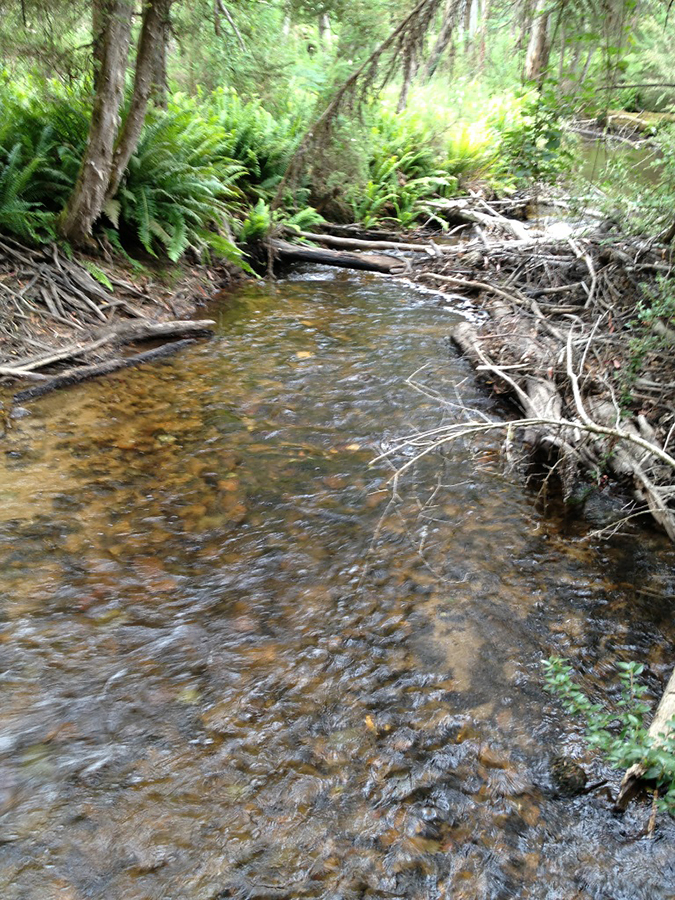
Dropped Eucalypt litter – Arnold Creek
On the larger streams, these get washed downstream or deposited in specific areas outside the main feeding lines, but on smaller streams, this litter hangs around everywhere making drifting nymphs a frustrating experience. In some streams, every cast with a nymph will snag a leaf or a twig or one of the long strings of bark. Then dry flies or neutral density nymphs are the only options for a snag-free drift.

When drifting a nymph is a frustrating experience – Unnamed stream
This is more pronounced during dry spells, as the trees shed a lot more leaves and branches than usual as a survival mechanism (That’s why it’s never advised to camp directly below any of the large gum trees that may drop a large branch at any time… they are not called widow makers for nothing!). These, combined with lower water levels during dry times, leave dry flies as the only option … but, trust me, one can still get snagged up even with dry flies as the twigs are sometimes just barely below the surface where the tippet or leader can find it. It’s not a break-the-fly-off kind of snag; it’s just having to constantly free the fly of an unwelcome friend after every drift! Some streams seem to have identical looking plant growth, but appear to have less of this problem. It may be due to them running a bit stronger after rain, thus cleaning out the stream, or it may just be that I am not that good at identifying the plant growth to understand which forest types are the neater growers.
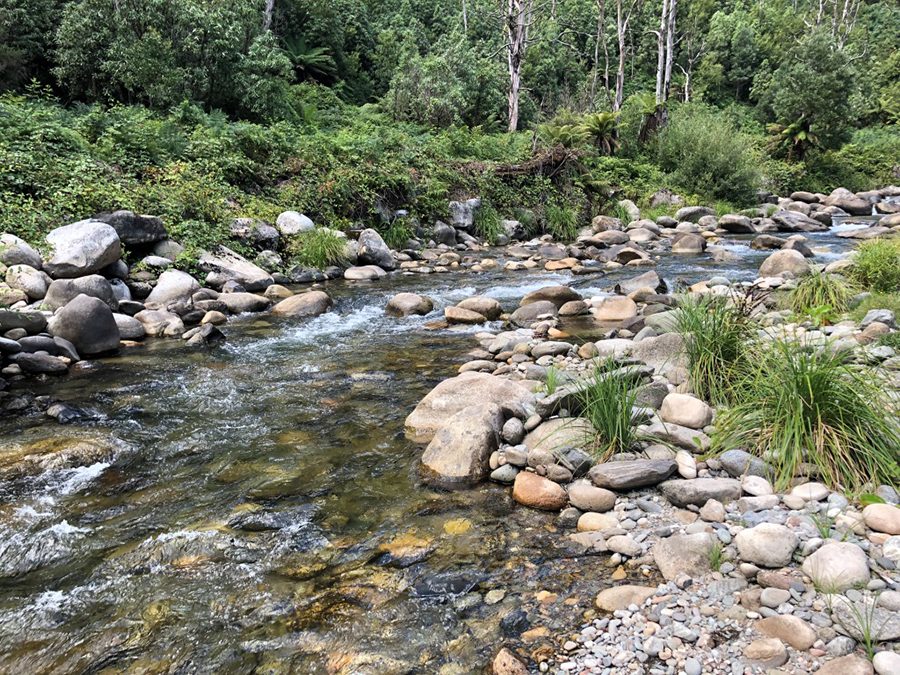
Less of a problem running a bit stronger after rain – West branch of the Kiewa River
Larger branches and trees fallen into and across the stream create instream homes for the trout, giving shelter against predation right in the feeding lanes and also scouring out nice pools, but they can play havoc with upstream progress for the angler, particularly in cases where the tree has fallen right across the stream and riparian vegetation or steep terrain makes walking the banks no option.
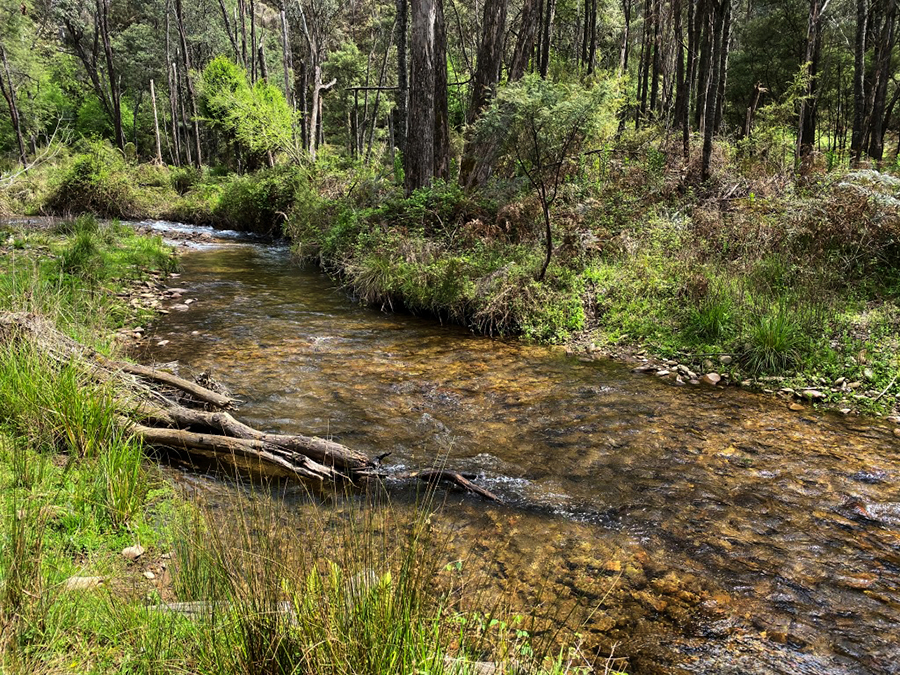
Branches can create upstream homes – The Ovens Stream
At this point, I would like to mention that some of these trees are of substantial girth and climbing over them is not always an option. The number of fallen trees can in some cases severely restrict the fishability of these small streams, not just in the angler’s ability to wade upstream. Sometimes there is just not enough water between the fallen trees to allow any distance for the fly to drift long enough. Luckily on some streams, the trees are a bit back enough from the water’s edge to allow better access.
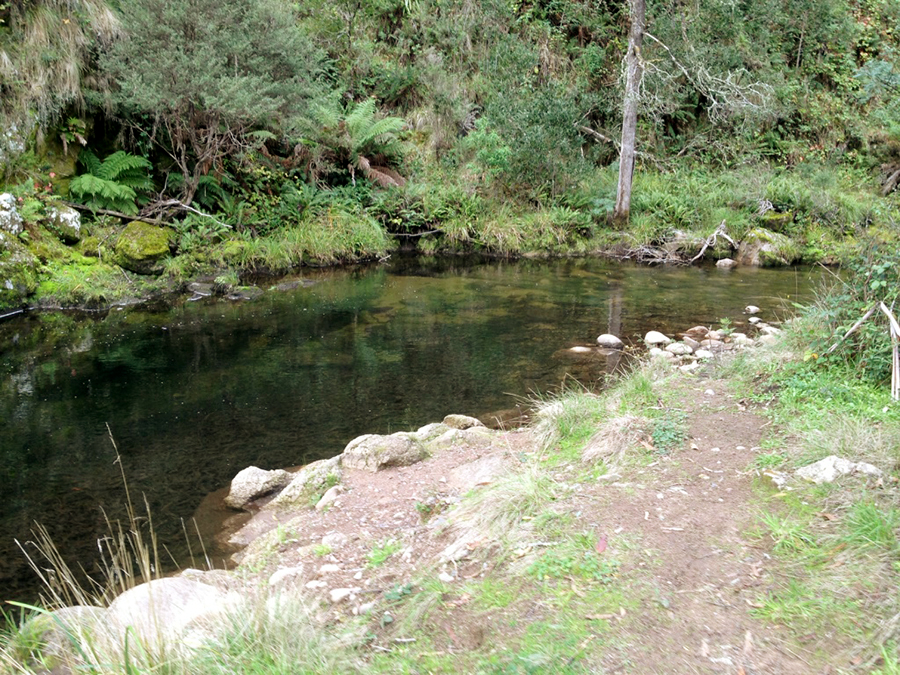
On some streams, the trees are back enough from the water’s edge – The King River
In the mid-1800s blackberries were introduced as a food source and fencing by the European settlers. These spread like wildfire with very little local enemies. Birds spread their seeds upstream, while the stream itself spread the seeds and stems downstream. Large sections of some of the best small streams are thus lined on both banks by intertwined walls of needle-sharp, wader-shredding hooks, virtually creating an instream prison… or at least a version of instream house arrest. In ‘normal’ sections of the small streams, particularly where the Eucalyptus forests are thinned out, tea trees hugging the water are your worst enemy for grabbing your fly and tying a professional Bimini twist super-knot in your leader around their stubby leaf-covered branches within milliseconds. But the blackberries are next-level evil. Sometimes after an hour of trying to extract your fly, and then most of your leader including eventually part of your fly line, and landing net, and clothes… then, cutting the fly line close to the leader and retiring for the day becomes a shameful option (hasn’t happened yet, but can’t confirm or deny with a straight face that these thoughts haven’t crossed my mind).

Silt substrate
The substrate in these small streams varies from area to area and sometimes within the same stream along its course. Mostly gravel, boulders, silt and at times bedrock. The bedrock sections are sometimes left-overs from the gold rush days when the stream beds were scoured of gravel in people's greed for the shiny yellow stuff.
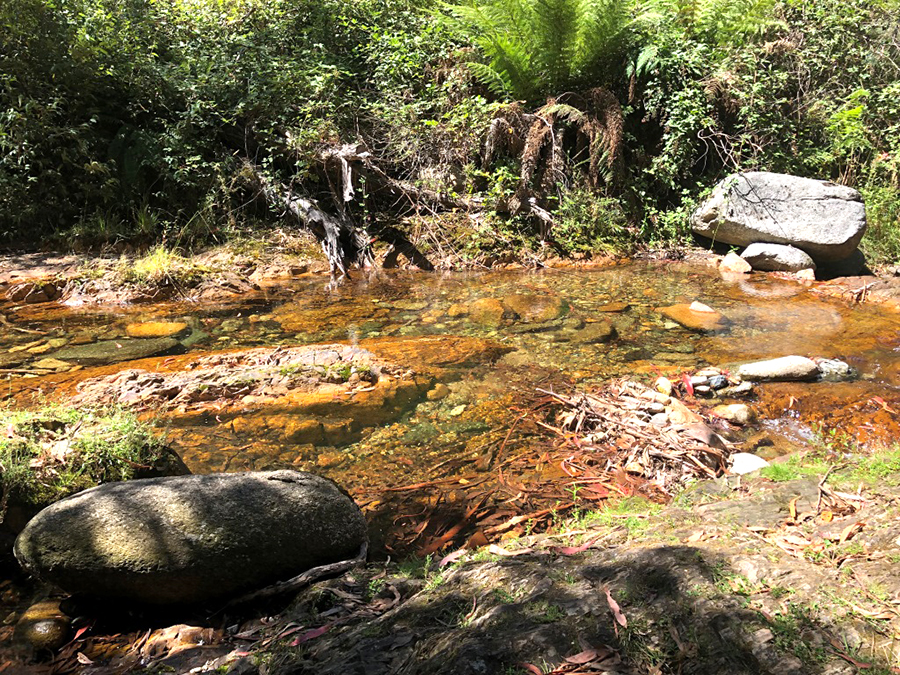
The Leatherbarrel
These areas seem to be additionally slippery while wading for some reason. Something I find peculiar is that some streams have large sections of mostly light coloured sand, almost like beach sand at times. Together with ultra-clear water, these sections don’t suite the trout’s colouration for camouflage, but they then seem to cleverly hold under low hanging branches in depressions in the sand. This can be frustrating as the trout is so clearly visible, but shielded from any kind of cast, or drift that the fly angler can dream of!

Boulders create perfect pocket water
On the steeper sections, rounded boulders create perfect pocket water. Pocket water is the fly fishing version of trench warfare. It’s mostly up close and personal, searching with brief drifts through lively small pockets of water formed between the clusters of boulders.

Perfect pocket water – The Taggerty Stream
These pockets also tend to be deeper than expected, but the surface takes are mostly energetic, as the trout has to race up from this deeper depth before the fly drifts out of the pocket Heart racing stuff. Luckily your approach is more easily masked, allowing the angler to get closer in to the pockets, but you also need an additional level of agility and a well-made pair of wading boots to traverse the terrain. Others may find it different, but I prefer to take the low ground while traversing these boulder fields, working my way in the water around the boulders, rather than over the top.
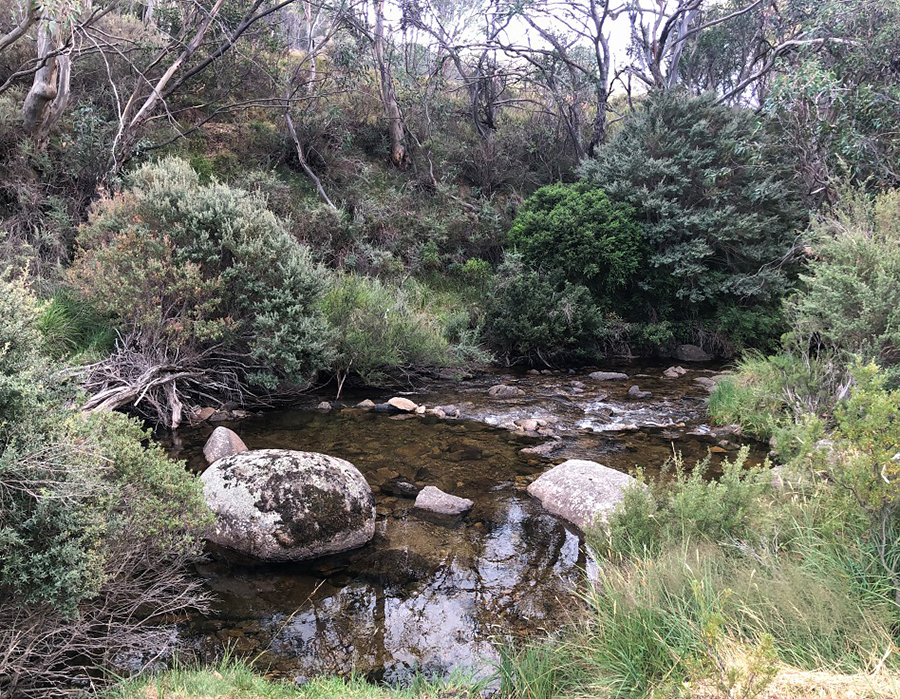
Work your way in the water around the boulders – The Threadbo
Fighting the current while feeling the ground with your boot to be sure of your next foothold takes longer, but you keep a lower profile, plus what goes up must come down and standing on a boulder and now having to jump down into water that’s always a lot deeper than it looks and bottom structure that is always a lot more uneven than it appears, doesn’t always end well.
My preference for flies for streams tends towards smaller sizes to match the stream and its residents. Predominantly darker nymphs in various weights from neutral through the range to lead wrapped and tungsten beaded bombs to get down in the swift runs, particularly early in the season when snow melt brims the streams. ZAK’s, GRHE and PTNs in various sizes work a treat and my favourite is to hang a lightly weighted lighter coloured flashback nymph 200-500mm behind a reasonably weighted dark ZAK. Experimentation is always on the cards and at times I like to tie on something unconventional to see what happens. Emergers work and I sometimes hang them off a larger dry fly, particularly if the leaf litter makes snagging a constant issue.

Dry flies are where small streams excel - Author's friend Daryl Human on Ogilvie's Creek
Dry flies are where small streams excel. The residents seem to keep a constant eye on the surface, whether there’s a hatch happening or not. Because the vegetation is in most cases right up to and into the water, terrestrials make up a large part of the trout’s diet. Beetles are a favourite and are most likely the reason for the success of one of Australia’s favourite flies, the Red Tag. Hoppers are up there as the most important terrestrial. Particularly when there’s a fair amount of grass around, the air temp up and wind blustery. Presentation is not as critical when fishing a hopper pattern, as a fly hitting the surface at speed that sort of mimics how a hopper hits the surface anyway. My preference as a fly pattern is for the Wee Creek Hopper by the late Murray Wilson. Easy to tie, easy to see, floats all day and gathers a bunch of key hopper indicators to entice the trout.
Stimulators are also very good and work great as a prospecting fly, particularly while hanging a small, light nymph off the back. A lot of local anglers like to use a large dry fly (like a stimulator) as an indicator, with a heavy nymph to trawl the depths, wanting to burn both ends of the candle, but I, personally, am not a fan. The dry flies never seem to ride the surface film right and then to combat this, the nymph is not weighed appropriately to get down to the correct depth where it needs to be… each to their own I suppose, but I have learned that trout, in particularly brown trout, can be fussy to a major OCD level. How the fly drifts outweigh the colour, size, and pattern most times out of ten.

Ovens Stream
General dries can be used the whole day, as hatches in the shade of the forest happen sporadically throughout the day, with the usual increase in activity approaching dusk when matching the hatch can be exacting at times. I prefer a para-hackle style with a bright coloured post that helps following the fly through its drift, particularly in low light areas. A locally developed humpy blow-fly pattern conveniently mimics Australia’s vast population of house and bush flies that can reach plague proportions particularly if the stream is anywhere close to where cattle are grazing. I love using a light coloured Elk Hair or Goddard Caddis of various sizes, even as a general searching pattern. I have tried the RAB very successfully on these small streams, but my tying abilities let me down severally in my attempts at replenishing the ranks and I have long since lost all my RAB’s to the surrounding scenery. I do know of a couple of remaining RAB’s in one of my favourite fly boxes, but this particular fly box is currently making its way down the mighty Murray-Darling river system heading for Adelaide… (Note to self… remember to zip close that pocket properly next time before fishing further!)
A sub-set of small streams are the alpine streams running above the tree line, mostly running through open tussock grass plains. These are snowbound for large parts of winter and most have had snow falling in any of the months of the year, so be ready to dress accordingly even in the dead of summer. Getting to these can be reasonably straight forward in some cases, but time-consuming as the roads up to them tend to snake laboriously up steep, rough mountainsides.
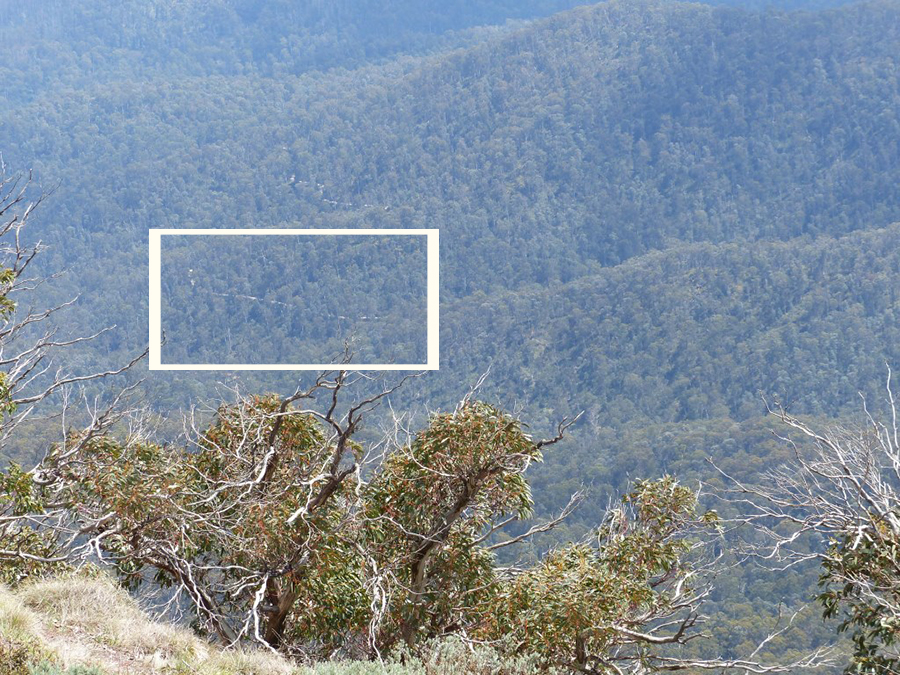
Tight, rugged 4x4 tracks hug the contours as seen above.
Some may require a reasonable to extremely lengthy hike in to get to the better places. From afar the hike in appears easy, flat, open grass plains, but the tussock grows in elevated clumps with the ground in between is a lot less level and the unevenness hidden by the grass and in many cases swampy. A good set of hiking boots are required to guard against twisted ankles, plus sturdy, thick gaiters to guard against snake bites and to keep the sharp grass seeds out of your boots. Up here, at certain times of the year (the name will give you a hint) horse flies, or march flies as they are locally called, can be a pest and more so the closer to the water you are. They can deliver their excruciatingly painful bite through surprisingly thick fabric, so be warned. These bites can severally impinge on your ability to concentrate on your fly’s drift at critical times! They seem to be attracted to darker colours and the rumour is that they’re particularly fond of darker shades of blue, so dress accordingly.
These snow plains have a beauty of their own, tussock grass waving in the breeze, surrounded by stands of snow gums with their weather-worn, twisted branches, smooth light coloured blotchy bark, hinting at the struggle of harsh, bitter winters past. If you are lucky you may come across majestic herds of wild brumbies (horses), while they lazily feed, oblivious of the, mostly inner city-bound, environmentalists shouting for their death sentence without ever actually venturing out to come have a look for themselves if their claims stack up. Unfortunately, these same environmentalists are turning their bloodthirsty gaze towards our speckled, finned friends, wanting to remove their shadows from the stream beds…
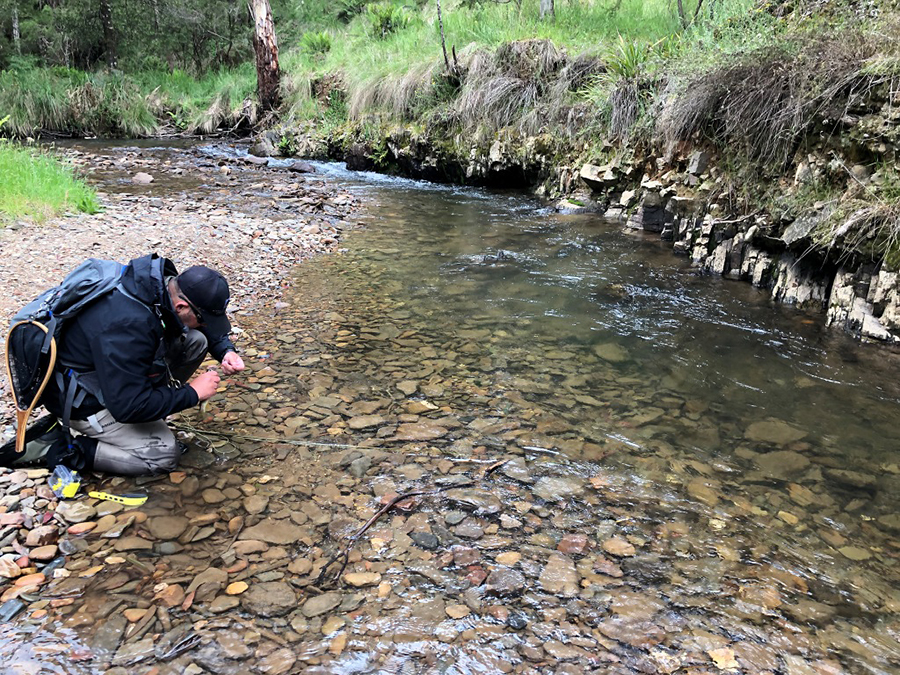
Daryl Human releasing a trout on Wood's Creek
These alpine streams meander across the snow plains seemingly lost as to which direction they are heading. Up here the substrate tends to be fine to coarse gravel, forming beautiful runs linking pools that invariably form at every bend. The stream cuts in under the tussocks that stabilise the banks, providing perfect housing for the trout even along the straight, riffled runs. Drifting the fly close to the bank is the best option if you can keep the fly out of the overhanging tussocks. If your fly did end up in the grass, it’s sometimes advisable to allow the water's drag on the fly line try to pull it off the grass and into the water… most cases there will be a pair of waiting eyes looking up and following your fly’s progress down the grass stalk with anticipation… be ready for the take! Hoppers are a must-have pattern for summer even at these high altitudes, but the white Elk Hair Caddis is popular to imitate the brilliant white snowflake-caddis that hatch in spiralling clouds on these alpine streams. Another popular range of flies are the Kossie Dun patterns (named after Australia’s tallest mountain, Mt. Kosciuszko) imitating light coloured mayflies that frequent these alpine streams.
As for fly tackle, light to ultra-light setups is the go. I recon no bigger than 3-wt is required and in the forested areas, shorter rods will suite better. I do like longer rods a little more on the alpine streams, as you are normally able to keep your cast above the tall tussock grass when you are down in the stream bed. In pocket water the longer rod can help high sticking, to leave as little as possible line on the water while following the fly’s progress through the pockets between rounded boulders. Accurate casting is required, particularly in the alpine streams, as the opening between the overhanging vegetation can be tight and the wind can play tricks. Where the vegetation allows, light, long leaders are the go. Learning to do roll cast is a must because the room for a backcast can be very limited at times and when things get really tight a bow and arrow cast is sometimes the only option.
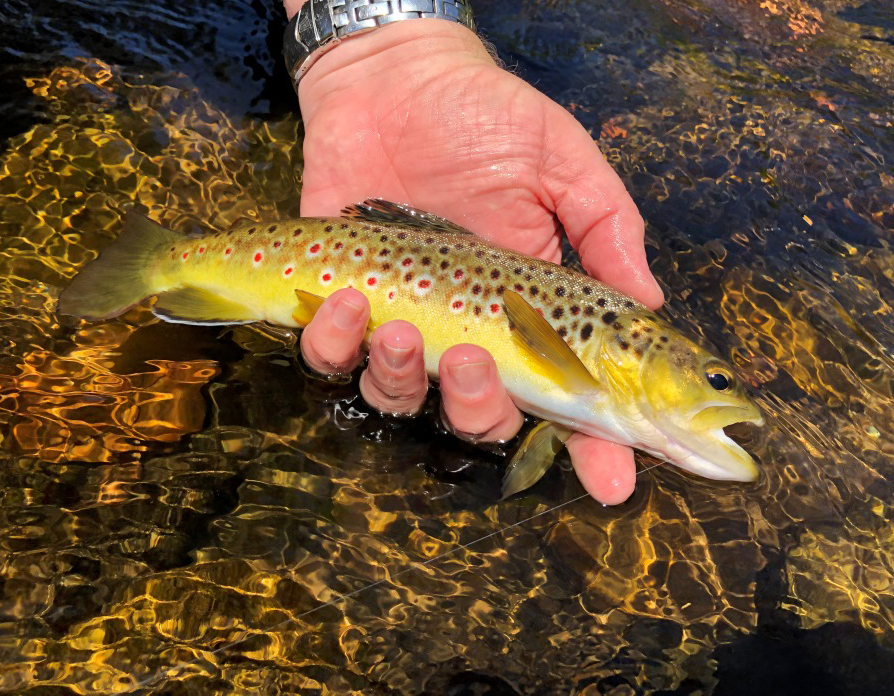
Both brown and rainbow trout are available in most streams with some conditions favouring the one over the other. There are a few streams that I know of only holding rainbow trout and less than a handful that hold wild spawning brook trout mixed in with the rainbows. Sizes are on the small side, but that’s what one would expect from small streams and this has never been a factor, but some of the small streams feed either into large rivers or lakes and larger fish do move up into these small streams to spawn and some stay over for a summer vacation, so be prepared to have your fine tippet tested at times. Expect to see plenty youngsters, still adorned with parr marks, but most are naturally wild spawned and displaying beautiful vivid colours and white-tipped fins.
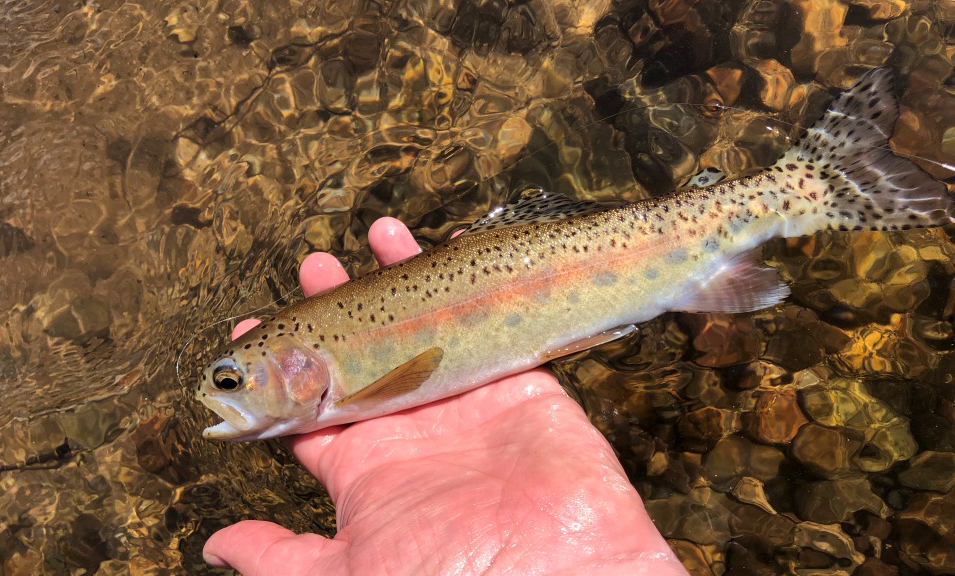
Some of the streams were heavily altered during the 1800’s gold rush days, but the more unfortunate legacies are the amount of heavy metal contamination that still lingers in these particular streams. I normally catch and release everywhere I fly fish anyway, but in these streams, in particular, it’s probably advisable not to eat the fish, as mercury poisoning or similar is a real possibility. I have caught some horribly miss-formed fish out of these streams including one that literally had most of its bottom jaw missing with only a stump on each side protruding forward… and yet it looked fat, healthy and had my fly firmly in the scissors of the deformed lower jaw!
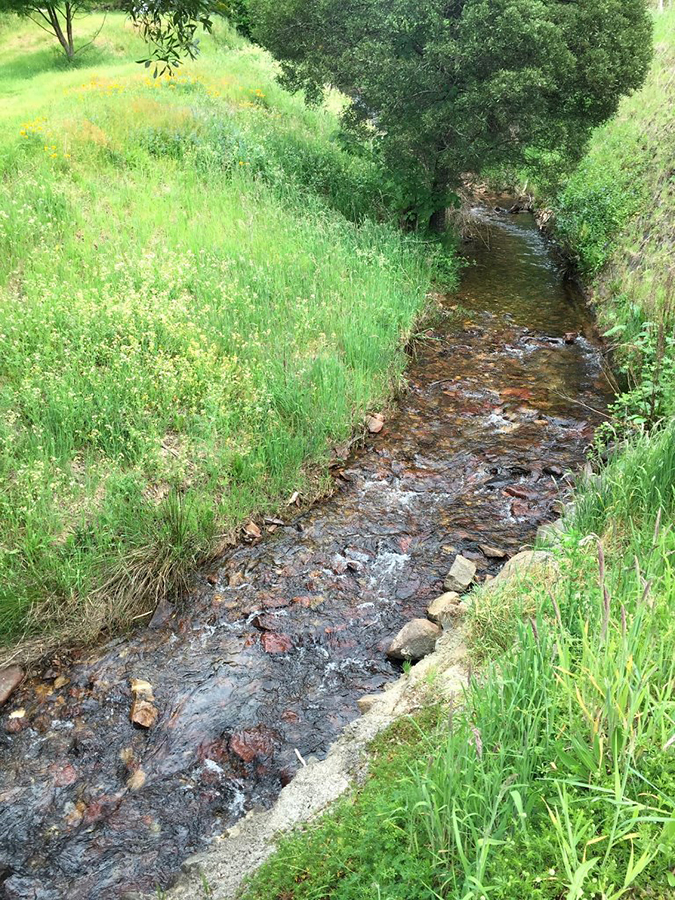
Morning Star Creek
Hunting small streams in mainland Australia is a very rewarding adventure. If you like to fish in solitude and are willing to put in the effort, the reward can well and truly worth it!
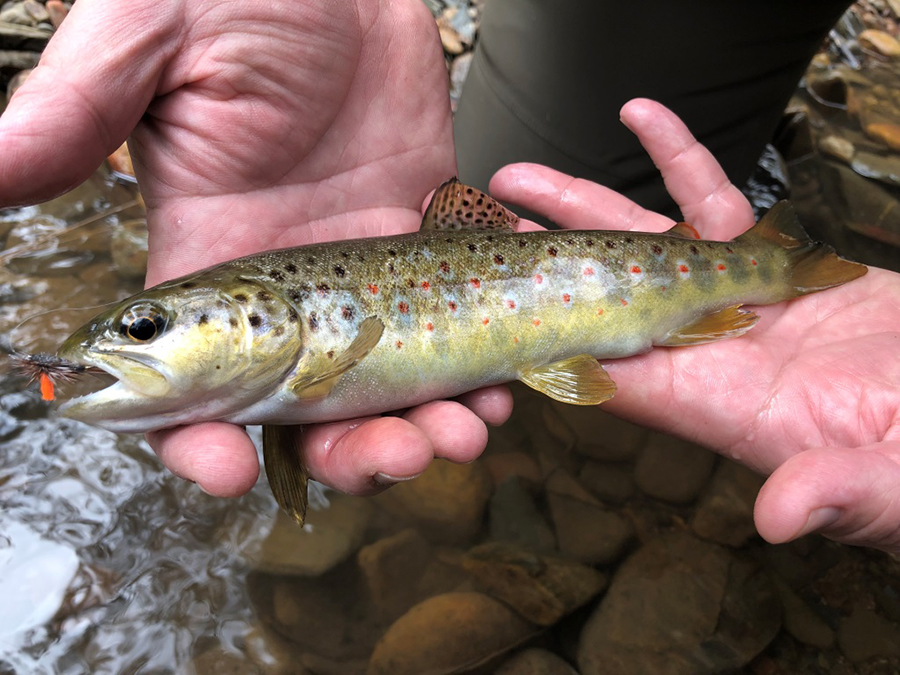
A word of appreciation.
Arno is already well known to many South African anglers for his evocative images of Australia's small streams and their fish, which he loads from measured post to measured post on Facebook. Those with a particular love of the diminutive cast, the less-than-beaten-track, of the truly Lilliputian fly fishing haven, will resonate well with his own such streams down under, each of which could make anybody’s list of 'My Most Wonderful Fishing Places Ever'. He shares them generously, whilst, I suspect, not letting any of his special 'cats' out of the bag – which, if it is so, we would fully understand. I offer him many, many thanks. Tom Sutcliffe.



